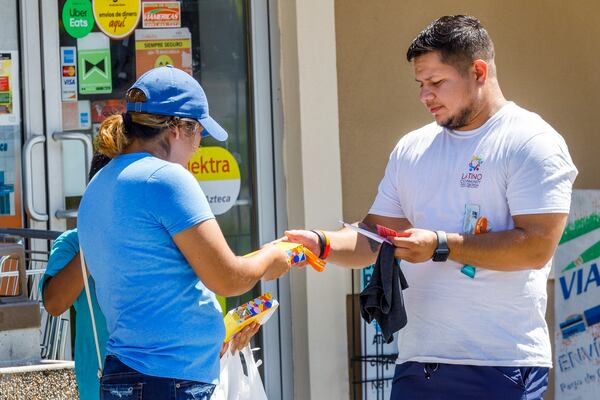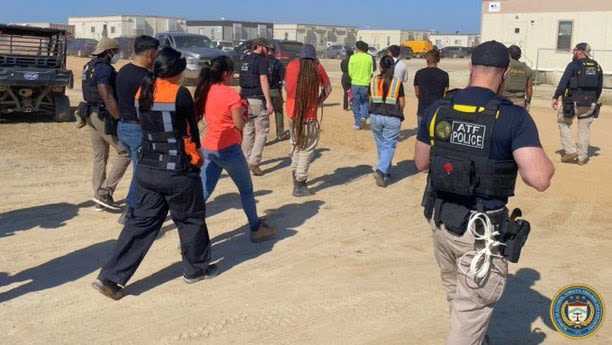With increasing temperatures, workers in professions such as agriculture and construction are pending with growing health threats.
However, the federal law offers only a few specific protective measures for employees from the heat – not even prescribed water and shadow breaks. Some states have enacted their own standards, but Georgia is not one of them.
Agricultural workers, roofers, construction workers and others who spend their days in the hot sun of Georgia are at the greatest risks that are exposed to heat -related diseases or deaths, say experts. And the risk lies more on immigrants, racial minorities and Georgians with low incomes that these jobs have more often.
The past decade was the warmest in the Southeast region. The average temperature of the Georgia for the six -month period from May to October has been increasing since 1995.
The latest data from this summer show no relief on the horizon. The average admission rates in connection with heat-related diseases to the emergency room from May to June of this year were in the southeast in the southeast in the last three years according to a report by the Health and Human Services Department in the United States.
Dr. James Ellis, the chairman of emergency medicine in the Piedmont Henry Hospital in Stockbridge, said that he and his colleagues had seen an increase in patients with heat diseases this summer – especially for people who work outside.
“Construction, roofer, landscape designer – that is definitely the vast majority,” said Ellis.
Further outside of the big cities, it is often agricultural workers.
Lupe Gonzalo has harvested plants such as tomatoes in Georgia and throughout the southeast for 12 years and worked for a long time in punishing the heat.
“Sometimes the sun feels as if it actually burns her back when working,” said Gonzalo and spoke through an interpreter. “Often the workers will be fainted or affected because they are dehydrated and overheated.”
Credit: Coalition of immocala workers
Credit: Coalition of immocala workers
The federal heating standard of the federal government is slowly moving
Today Gonzalo travels from state to state and agriculture to educate agricultural workers about their rights for the coalition of immocale workers. In her experience as a worker and organizer, she said that it was not uncommon for people who work in the fields to be rejected or discouraged even with heat waves from breaks and access to shadows and water.
None of these protective measures are prescribed. Last year, the US Ministry of Labor announced its intention to issue its first rule for heat injuries and prevention prevention, but the process of regulation could take years and face the opposition of the industry. Some interests of interest such as public citizens have asked the agency to move earlier and take emergency measures.
Employers currently have to provide a secure working environment in accordance with a general service clause of the Act on Occupational Safety and Health in 1970. In contrast to areas such as chemical exposure, there are no specific standards or protocols in terms of heat safety.
The creation of a new standard for heat-related injuries and illness prevention “would make the employer's obligations more clearly”, wrote a spokesman for the Ministry of Labor in an email. “The regulation takes time and it is important that we do it right.”
Credit: arvin.temkar@ajc.com
Credit: arvin.temkar@ajc.com
Some supporters have concerned that the rule could be weakened or ejected by the U.S. Supreme Court, which recently tried to restrict the government's ability to regulate important problems.
“I think it is unlikely, but the dish could be conceivable that heat problems are not covered by the general service clause of the OSHA and can therefore only be regulated, unless the congress receives a specific authority to authority,” wrote the working lawyer Michael Schönfeld in an e -mail. “If Osha lists climate change as the basis for a heat -related rule, this will definitely be opened for a close examination.”
Risk higher for agricultural construction workers, construction workers
The southeast is expected to continue to heat in the coming decades. If greenhouse gas emissions continue to rise by the end of this century, the temperatures above 95 degrees could be very common, according to the US climate Resilience Toolkit tool released by the Federal Government, especially in Central and South Georgia.
Chris Butts, Executive Vice President of Georgia Obst and Vegetable Growers Association, said it was too early to say whether his organization would push back a proposed new federal rule because no draft was published.
Butts confidently commented that the members of his association, which represent around 90% of the state's great producers, have already done the right thing to do by their employees.
“Our producers don't necessarily need OSHA standards or regulations to do the right thing,” said Butts. “It also takes care of your employees when they take care of another well, and that means protecting them.”
However, a new top -class case underlines the susceptibility of agricultural workers to the requirements of their employers. Last year, the Federal Prosecutor's Office “Operation Blooming Onion” presented a spacious examination of gross human rights violations against migrant workers in South Georgia farms, including two people who died according to the indictment of heat stress.
Butts emphasized that neither of the two dozen accused is members of his organization.
“Would increased regulations record some of these bad actors? Possibly,” said Butts. “The good actors are not afraid of reasonable regulations.”
Some states, including California, Minnesota, Washington and finally Oregon, have initiated their own heat standards, most of which require access to water, shadows, special training, breaks and acclimatization for new employees. Georgia has no heat standards at the state level.

Credit: Colin Hackley
Credit: Colin Hackley
The proposed rule of Osha would apply to work locations indoors and outdoors. But people who work outside are particularly susceptible to heat sickness and death. According to a study, agricultural workers die 35 times more often from the heat than workers in other industries. Construction workers were 13 times more likely. Together, agriculture and construction made 58% of the warmth of death over the period of 10 years, which was covered in the study.
According to its public database, Osha has examined at least five heat deaths in Georgia since 2017 and a handful of heat-related diseases. A spokesman for the Ministry of Labor wrote that the agency had never examined one of the accused in the indictment for operating blooming onion.
According to Roxana Chicas, an assistant professor at the Nell Hodgson Woodruff School of Nursing, the list of OSHA is probably a settlement. Chicas examines professional health, especially for Spanish -speaking immigrants who make up a large majority of the workforce in agriculture and construction.
Many employees in these industries are migrants who earn very little money and rely on their employers, and they often hesitate to search for medical help or to submit complaints, regardless of their legal status. Chicas also said that heat -related diseases or death in the hospital or in the body house are not recorded properly, especially if heat makes a contribution.
“When a construction worker works on a roof and he falls, it will probably be” coded, “she said. “But it could have been caused by excessive heat exposure that was dizzy and dizzy.”
According to Chicas, employers should be legally obliged to adapt hours and provide shade, water, protective clothing and mandatory breaks. She was also committed to choosing odds or unit prices that pays the employees by harvesting and stimulating their limits.
“I think that there is still this term in society that believes that workers or farmers with a migration background can withstand the heat outdoors, and that's not the case,” she said. “You need protection, just like many of us.”
Israel Bello von Austeell has been working under construction for 15 years and said that working conditions vary from the employer to the employer, especially in an industry in which so much work is subordinate.
“It also depends on the leader of this crew who works,” said Bello. “Most of the time, these boys, they don't give you breaks, do you know? Sometimes I saw crews that they don't even have a cooler with water.”
According to Bello, workers who are affected by the heat can experience chills and cramps, and some become so sick that they cannot stop vomiting.
“Even if they feel sick, they don't want to say anything because they are fired or sent home,” he said.
Consumer printing grows with retailers, producers
In the absence of enforceable rules of state rules, some supporters of employee rights have successfully put pressure on the companies.
The coalition of immocala workers in which Gonzalo works has made a number of legal agreements for fair foods with retailers and producers who have obliged them to protect wage and security standards, including thermal insulation. The program started in Florida and has since spread to other states, including Georgia, where there are two tomato farms.
“The majority of our focus and our attention is to bring more companies into the fair food program,” said Gonzalo. “We have seen that it is important for them to have laws if there are laws that have enforcement mechanisms and give resources behind this enforcement, and that often does not happen.”
The participating retailers include well -known brands such as McDonald's, Walmart, Whole Foods and Trader Joe's. The list lacks two of the largest grocery stores in Georgia: Kroger and Publix.
According to Butts from the producer association, some retailers have initiated their own standards for their suppliers.
“We certainly see more social accountability and climate responsibility that these retailers want to be sure that their suppliers meet some standards,” he said.







